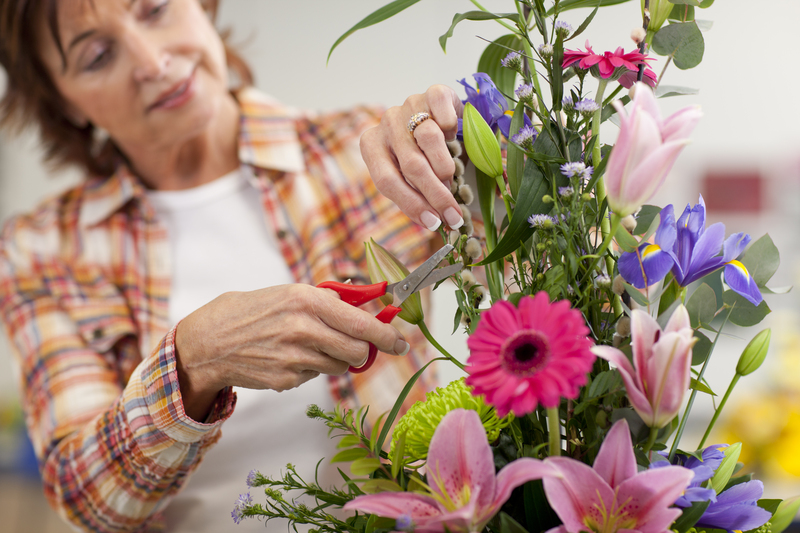Achieving Longevity for Your Cut Flower Arrangements
Posted on 29/08/2025
Achieving Longevity for Your Cut Flower Arrangements: The Ultimate Guide to Long-Lasting Blooms
Looking to extend the lifespan of your cut flower arrangements? Whether you're decorating your home, preparing for a special occasion, or simply indulging your love for fresh blooms, knowing how to keep your floral creations vibrant for days or even weeks is an invaluable skill. In this comprehensive guide, we'll uncover everything you need to know about preserving the beauty of cut flowers and maximizing their freshness in any setting.
Why Do Cut Flowers Wilt?
Before exploring the best practices for achieving longevity in your flower arrangements, it helps to understand why cut flowers deteriorate in the first place. The moment a flower is separated from its parent plant, it loses its natural water and nutrient supply. Without immediate and proper care, this can hasten the aging process, resulting in wilting, faded hues, and early drooping petals.
- Loss of hydration — Water evaporates rapidly from cut stems and petals, making cells shrink and wilt.
- Bacterial growth in vase water introduces toxins that block nutrient and water absorption.
- Lack of food — Once cut, flowers can no longer produce or draw in sugars for energy.
- Environmental stress such as heat or direct sunlight accelerates the decay process.
By mitigating these dangers, you can dramatically prolong the vibrancy of your cut flower displays.

Choosing the Right Flowers for Long-Lasting Arrangements
Not all flowers are created equal when it comes to vase life. Some species, thanks to their robust genetic makeup, naturally have better staying power as cut blooms. If your goal is to boost the longevity of your floral designs, consider these proven long-lasting varieties:
- Chrysanthemums – Often last over two weeks with proper care.
- Alstroemeria (Peruvian Lily) – Can remain fresh up to 14 days.
- Carnations — Known for an extraordinary vase life of up to three weeks.
- Orchids — Especially Cymbidiums and Dendrobiums, famed for their endurance.
- Zinnias – Strong stems and petals make them resilient choices.
- Sunflowers – Hardy and bright, often outlasting more delicate blooms.
- Lisianthus – Lasts up to two weeks in water.
- Gladiolus – Flowers open successively for a prolonged display.
It's also beneficial to purchase cut flowers early in their life cycle--buds that are just starting to open will naturally outlast fully open blooms.
Preparing Flowers for Maximum Vase Life
How you prepare your blooms makes a significant impact on the longevity of cut flower arrangements. Follow these expert steps:
1. Use Clean Tools and Vases
- Always use sterile scissors, pruners, or knives to prevent introducing bacteria to flower stems.
- Wash your vase thoroughly with hot, soapy water and rinse well. Residues may harbor harmful microbes.
2. Trim the Stems Correctly
- Cut stems at a 45-degree angle to maximize water absorption and prevent them from sitting flat on the vase bottom, which can block intake.
- Remove any leaves that would sit below the water line to prevent rot and bacteria buildup.
3. Condition Flowers
- Allow newly cut flowers to rehydrate in a cool, dark place for a few hours before arranging. This improves turgidity and freshness.
- For woody stems like lilacs and roses, make a vertical slit or gently smash the base to enhance water uptake.
4. Immediate Hydration
- Place stems in lukewarm water directly after cutting. Changing water temperature helps eliminate air bubbles that can block hydration.
Creating the Perfect Conditions for Long-Lasting Flower Arrangements
Your attention shouldn't stop once flowers are in the vase. Environmental factors play a critical role in determining how long flowers remain fresh. Here are key considerations:
Water Quality and Maintenance
- Change vase water every two days to keep bacteria at bay.
- Use filtered or distilled water if possible, as tap water may contain chemicals harmful to flowers.
- Rinse stems briefly with each water change and trim a small portion off the end to refresh the drinking surface.
Optimal Location
- Keep arrangements out of direct sunlight, heating vents, and drafts.
- Cooler temperatures slow the aging process for most cut flowers. Place arrangements in the coldest room overnight if possible.
- Keep arrangements away from ripening fruits and vegetables, which release ethylene gas that accelerates flower aging.
Flower Food: Is It Necessary?
Commercial flower foods are not a marketing ploy—they're formulated to extend vase life by nourishing stems and limiting bacterial growth. Packets of flower preservative typically contain:
- Sugar (for energy)
- An acidifier (to maintain the proper pH)
- Bleach or biocide (to reduce bacteria)
If your flowers didn't come with a packet, you can make a simple homemade solution:
- Mix 2 teaspoons sugar, 2 teaspoons lemon or lime juice, and a few drops of bleach in a quart of water.
- Stir well and add to your vase for similar benefits.
Special Tricks and Tips for Extending Flower Arrangement Longevity
Beyond the basics, advanced florists and enthusiastic home decorators alike rely on tried-and-true tricks to prolong the vitality of cut flower arrangements. Use these ideas to get the most out of every bouquet:
Prune and Remove Fading Flowers Promptly
- As blooms start to wilt, snip them off--the ethylene they emit can hasten the decline of healthy flowers nearby.
Support Heavy Blooms
- Use floral tape or chicken wire inside the vase to support larger heads (like hydrangeas or sunflowers) and keep stems upright, preventing premature bending or snapping.
Use Clean Hands and Surfaces
- Handle flowers as little as possible, and only after washing your hands to avoid transferring oils or bacteria.
Mist with Water Daily
- Light misting, especially in dry climates, keeps petals hydrated and less prone to browning.
Common Myths About Cut Flower Care
It's easy to get lost in old wives' tales and home remedies purporting to extend vase life. Let's separate fact from fiction:
- Pennies in the vase? Not effective for most modern pennies (they're mostly zinc, not copper).
- Aspirin in the water? May adjust pH slightly but isn't as effective as commercial flower foods.
- Sugar without bleach? Feeds both flowers and bacteria--a combination is essential!
For maximum longevity, stick to the proven, science-backed methods outlined in this guide.
How to Revive Drooping Flowers
Sometimes, despite your best efforts, flowers start to wilt early. Don't despair! Several quick fixes can breathe new life into tired arrangements:
- Submerge the entire stem (including the flower head) in cool water for 30 minutes. This extreme hydration can re-inflate turgid cells.
- Re-cut stems under water to reopen drinking channels and eliminate air bubbles that restrict flow.
- For firm flowers like hydrangeas, try turning the bloom upside down and soaking the head in water for 15-30 minutes; their petals absorb water directly from the surface.
Longevity for Specialty Arrangements: Roses, Tulips, and More
Roses
- Remove guard petals (the tough, outer petals) to help blooms open fully and minimize rot.
- Re-cut stems every two days, and use a vase tall enough to support their weight.
- Roses benefit from cool storage at night; refrigerate if possible.
Tulips
- Tulips will continue to grow in the vase, often bending dramatically towards light.
- Keep tulips separate from daffodils, which exude a sap toxic to other flowers.
- Wrap stems in paper after arranging to help them stand upright until fully hydrated.
Daffodils
- Allow cut daffodils to sit in water alone for a few hours before adding to mixed bouquets to remove their sap.
Eco-Friendly Tips for Sustainable Flower Arrangements
Achieving longevity for your cut flowers doesn't have to come at an environmental cost. Try these approaches for sustainable, long-lasting bouquets:
- Support local growers to reduce the environmental impact of transporting flowers long distances.
- Repurpose faded flower heads for homemade potpourri or pressed flower crafts.
- Compost organic waste from trimmed stems and leaves.
Seasonal Considerations for Prolonged Vase Life
Different weather conditions impact how quickly flowers deteriorate. Summer heat can shorten bloom duration, while winter's dry air can cause dehydration.
- In summer, use ice cubes in the vase to maintain cool water temperature.
- During winter, lightly mist blooms or use a small humidifier in the room to counteract dryness.
Summary: Key Steps for Achieving Longevity for Cut Flower Arrangements
Achieving long-lasting beauty from your cut flower arrangements is a blend of art, science, and attentive care. To recap:
- Select sturdy, long-lasting blooms and buy them fresh.
- Prepare vases and tools by ensuring total cleanliness to eliminate bacteria sources.
- Trim stems and remove submerged foliage immediately before arranging.
- Use fresh, filtered water and change it regularly, refreshing your flower food as you go.
- Keep flowers cool and away from direct sunlight or ripening fruits.
- Remove wilted blossoms to protect the remaining arrangement.
- Employ special tips for reviving tired flowers or supporting heavy blooms.
With perseverance and mindful care, you can enjoy your cut flower arrangements at their peak for much longer. No matter your skill level or occasion, these practices empower you to make the most of every bouquet!

Frequently Asked Questions: Flower Arrangement Longevity
What is the longest-lasting cut flower?
Carnations and Alstroemeria rank among the longest-lasting cut flowers, frequently remaining fresh for two weeks or more with proper care.
How often should I change the water in cut flower arrangements?
It's ideal to change the water every 2 days. This practice keeps bacterial growth under control and refreshes the stems' water supply.
Is it necessary to include flower food?
Flower food maximizes bloom longevity by balancing nutrients, pH levels, and bacteria inhibitors. While not absolutely required, it significantly improves vase life.
Why do my flowers droop quickly?
Rapid wilting is often due to clogged stems (from bacteria or air bubbles), dehydration, or exposure to drafts, fruit, or excessive heat. Follow our guide above for targeted solutions.
Conclusion: Enjoy Your Flowers Longer, Every Time
Achieving longevity for your cut flower arrangements is both a joy and an achievable goal. With a few simple strategies, some scientific know-how, and a touch of creative energy, your bouquets will remain a source of beauty and inspiration. Practice these methods and transform every floral arrangement into a lasting celebration of nature's finest offerings!
Latest Posts
Maintain a Vibrant Workspace with Minimum Care Plants
Achieving Longevity for Your Cut Flower Arrangements
Vital Orchid Care Practices Explained






